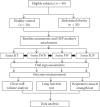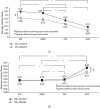Total and Compartmental Chest Wall Volumes, Lung Function, and Respiratory Muscle Strength in Individuals with Abdominal Obesity: Effects of Body Positions
- PMID: 31934446
- PMCID: PMC6942872
- DOI: 10.1155/2019/9539846
Total and Compartmental Chest Wall Volumes, Lung Function, and Respiratory Muscle Strength in Individuals with Abdominal Obesity: Effects of Body Positions
Abstract
Background: Abdominal obesity is a chronic condition that can contribute to impairments in lung function, leading to increased risks for respiratory-related diseases. Body position is an important technique that effectively restores and increases lung function and chest wall volumes. The objective of the current study was to examine the effects of the body positions on total and compartmental chest wall volumes, lung function, and respiratory muscle strength in individuals with and without abdominal obesity.
Methods: Twenty obesity and twenty healthy males performed in four body position including sitting without and with back support, Fowler's, and supine positions. Each position was performed for five minutes. Chest wall volumes, lung function, and respiratory muscle strength were assessed in each position.
Results: Sitting without and with back support resulted in higher total and rib cage compartmental chest wall volumes, lung function, and inspiratory muscle strength than Fowler's and supine positions in both groups (p < 0.001). Abdominal obesity subjects had significantly less total and compartmental chest wall volumes and lung function across four body positions than healthy subjects (p < 0.001). Respiratory muscle strength in the obesity group was less than that in the healthy control group (p > 0.05).
Conclusions: This study provides new information regarding the effect of obesity and body position on chest wall volumes, lung function, and respiratory muscle strength. Among obesity individuals who are bedridden, sitting increases lung function, total and rib cage compartmental chest wall volumes, and inspiratory muscle strength-and would therefore likely to decrease the risk of respiratory-related disease-relative to Fowler's and supine positions.
Copyright © 2019 Rattanaporn Sonpeayung et al.
Conflict of interest statement
The authors declare that there are no conflicts of interest regarding the publication of this paper.
Figures




References
Publication types
MeSH terms
LinkOut - more resources
Full Text Sources
Medical

